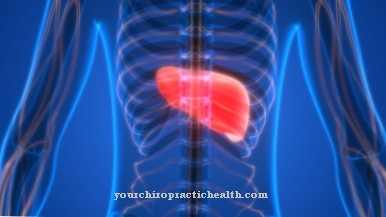The Conversion phase is the final phase of the five-phase secondary fracture healing. The simultaneous activity of osteoclasts and osteoblasts removes old bone mass and builds up new bone substance. In osteoporosis, the activity of the osteoblasts and osteoclasts is disturbed.
What is the conversion phase?

The complete severing of a bone by indirect or direct force is also known as a fracture. When a bone breaks, two or more fragments are formed which can usually be put back together therapeutically.
Bone fractures are either directly primary or indirectly secondary fractures. In the case of direct invoices, the break ends are directly next to one another. Indirect fractures, on the other hand, are characterized by a gap between the ends of the fracture. Fracture healing is either primary or secondary, depending on the type of fracture. During secondary fracture healing, a visible callus, also known as a bone scar, forms.
Secondary fracture healing takes place in five phases. The injury and inflammation phase is followed by the granulation phase and callus hardening. At the end of the secondary fracture healing, there is the so-called remodeling phase, which consists of modeling and remodeling processes. The bone grows as much as it is broken down. In this way, a stable skeletal system remains in the body even after fractures have healed well.
Function & task
The red modeling of bone tissue is used to build up new bone tissue and to remove old bone tissue. The process is relevant to the healing of indirect fractures. However, it also takes place in the body independently of bone fractures in order to adapt bone structures to loads.
In addition to osteoclasts, osteoblasts are involved in the process. Osteoclasts are cells with multiple nuclei. They are formed by the fusion of mononuclear precursor cells in the bone marrow and are part of the mononuclear phagocytic system. This makes them one of the cells of the reticular connective tissue. Their tasks include, above all, work on breaking down the bone substance.
On the other hand, bone formation is carried out by the osteoblasts. These cells arise from undifferentiated cells of the mesenchyme and are therefore embryonic connective tissue cells. They attach to the bones like layers of skin and thus form the basis for new bone substance. This basic structure is also known as the bone matrix and is created by the excretion of type 1 collagen and calcium phosphates or carbonates in the interstitial space.
During bone formation, the osteoblasts become a framework of osteocytes without the ability to divide. This framework mineralizes and is filled with calcium. The network of osteocytes is stored in the newly formed bone.
As a repair mechanism, the remodeling phase minimizes bone wear and tear and maintains a stable and functional skeleton. Structural damage caused by everyday stress is corrected by remodeling and the micro-architecture of the bone is adapted to the stress conditions. In fracture healing, remodeling plays a role primarily in the form of remodeling work on the callus. The restructuring process creates a fully resilient bone.
The osteoclasts break down the bone matrix during remodeling and the osteoblasts build up new bone substance via the intermediate stage osteoid. The osteoclasts dig themselves into the bone matrix through lytic enzymes such as cathepsin K, MMP-3 and ALP, where they form resorption lacunae. In fields of around 50 cells, osteoblasts secrete the new skeleton. In the further course of this, this collagen base is calcified and thus results in a stable bone. The conversion processes are probably subject to a higher-level control system, which is also known as coupling. The exact regulatory mechanisms of remodeling are not yet known.
Illnesses & ailments
Remodeling plays a role in diseases such as osteoporosis in the elderly. The bone density decreases with this disease. In osteoporosis, bone substance breaks down excessively quickly. The osteoblasts can hardly keep up with the development of new substance. This makes patients more prone to fractures. In addition to vertebral body collapses, femur fractures near the hip joint, spoke fractures near the wrist and fractures of the humerus head often occur. Pelvic fractures are also a common symptom of osteoporosis.
The most common cause of osteoporosis is an insufficient build-up of bone substance during the first three decades of life. Up to the age of about 30 years, the bone substance increases permanently due to the activity of the osteoblasts. A healthy person builds up so much bone substance in the first three decades of life that the increased breakdown work in the later decades of life does not cause any complications.
There can be various reasons why osteoporosis patients have built up too little bone substance in the earlier decades of life. Diet can play a role, for example. Other possible causes are inflammatory or hormonal diseases.
Osteoporosis is not the only disease that can cause modeling and remodeling problems. The processes of osteoclasts or osteoblasts can e.g. also be genetically impaired. In pycnodysostosis, for example, the activity of the osteoclasts is greatly reduced. The same is true for polycystic lipomembranous osteodysplasia or Nasu-Hakola disease.
An increased osteoclast activity is present in hyperparathyroidism, Paget's disease or aseptic bone necrosis. Rheumatoid arthritis, osteogenesis imperfecta or giant cell tumors can also cause the overactivity.
Dysregulated activities of the osteoblasts, on the other hand, mainly play a role in bone growth. A degeneration of the osteoblasts can, for example, cause osteoblastomas and thus a type of bone cancer.


.jpg)
.jpg)























